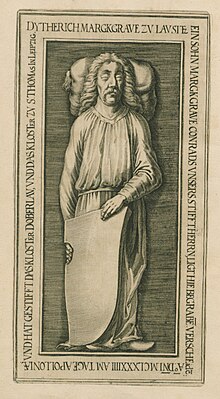Dietrich II (Lausitz)
Margrave Dietrich II. (* Before February 27, 1142 ; † February 9, 1185 ) was from 1156/57 Margrave of the Lausitz region with the later headquarters at Landsberg Castle . He came from a noble family that was called Wettiner since the 15th century .
Life
Dietrich was born at an unknown point in time as the son of Margrave Konrad von Meißen and, after his father renounced rule in 1156, received the margraviate Lausitz from Emperor Friedrich I Barbarossa as a fief .
Margrave Dietrich had Landsberg Castle built east of Halle as the new headquarters for his principality. Today only the double chapel St. Crucis, which was preserved after severe destruction at the beginning of the 16th century, bears witness to the impressive complex. Dietrich had brought an antique column from Italy to her structural equipment. In 1165, with the help of the Mazovian bishop Werner von Płock, he founded a house monastery in Dobrilugk for his family branch. He was a staunch opponent of Duke Heinrich the Lion , whom he feuded together with his relatives, Archbishop Wichmann of Magdeburg, Margrave Otto von Meißen and Count Dedo von Groitzsch and Rochlitz. Dietrich had a permanently good relationship with Emperor Friedrich Barbarossa, whom he met in Italy and especially in Venice in 1177 at the peace congress with Pope Alexander III. sustainably supported.
Dietrich died on February 9, 1185, after a long illness that broke out on the Mainzer Hoftag in 1184 . He was buried in the Augustinian monastery of St. Peter on the Lauterberg because the family burial place in Dobrilugk was not yet ready. His younger brother Dedo von Rochlitz-Groitzsch succeeded him as margrave after Friedrich Barbarossa had enfeoffed him with the Mark Lausitz against payment of a considerable sum (4,000 silver marks ). Dietrich was the first margrave of the Lausitz region with his own coinage. Its bracteates are of extraordinary, representative beauty. He also promoted the development of the state between the Elbe and Elster and in Lusatia.
Dietrich was married to Dobroniega, a daughter of the Polish Duke Bolesław III. Crooked mouth . From this marriage came two children: Konrad († 1175 accidental death in a tournament) and Gertrud, nun of Gerbstedt . At the same time he had a lover with Kunigunde von Plötzkau , the widow of Count Bernhard, who had fallen in the Holy Land, who gave birth to Dietrich, who later became Bishop of Merseburg († 1215).
literature
- Heinrich Theodor Flathe : Dietrich von Landsberg . In: Allgemeine Deutsche Biographie (ADB). Volume 5, Duncker & Humblot, Leipzig 1877, p. 186.
- Michael Lindner: Dietrich, Dedo and Konrad von Landsberg - Margraves of the Ostmark (1156–1210). A political and lordly sketch from the time of the high medieval country development. In: Stefan Auert-Watzik, Henning Mertens (ed.): Peripheries of Saxon history. Central Germany, Seeburg and Landsberg as dominion and cultural areas of the Ekkehardines and Wettins 743-1347 (= contributions to the Landsberg regional history. 1). Druck-Zuck, Halle (Saale) 2011, ISBN 978-3-940744-43-2 , pp. 267-290.
- Michael Lindner: Aachen - Dobrilugk - Plock. Margrave Dietrich von der Ostmark, Bishop Werner von Płock and the beginnings of the Dobrilugk Monastery. In: Heinz-Dieter Heimann , Klaus Neitmann , Uwe Tresp (eds.): The Lower and Upper Lusatia. Contours of an integration landscape. Volume 1: Middle Ages (= studies on Brandenburg and comparative regional history. 11). Lukas, Berlin 2013, ISBN 978-3-86732-160-0 , pp. 139-176.
- Michael Lindner: Dietrich (II.) Von Landsberg, Margrave of Ostmark / Lausitz. In: Saxon Biography. Published by the Institute of Saxon History and Folklore, Edit. by Martina Schattkowsky.
| predecessor | Office | successor |
|---|---|---|
| Konrad I. von Wettin |
Margrave of Lusatia 1156–1185 |
Dedo III |
| personal data | |
|---|---|
| SURNAME | Dietrich II. |
| ALTERNATIVE NAMES | Dietrich von Eilenburg |
| BRIEF DESCRIPTION | Margrave of Lower Lusatia and Landsberg |
| DATE OF BIRTH | before February 27, 1142 |
| DATE OF DEATH | February 9, 1185 |
